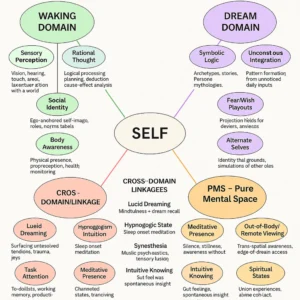Abstract
This paper introduces the Ultra-Molecular Worldview as a novel theoretical framework for modeling the multidimensional nature of human consciousness. Drawing inspiration from molecular visualization in chemistry, the model conceptualizes mental “domains”—Waking, Dreaming, and Pure Mental Space (PMS)—as interconnected nodes linked by cognitive bonds. Each bond symbolizes the possibility of transitioning between modes of awareness. This paper presents the underlying theory, supporting visual models, and a structured Think Map identifying sub-domains within each major domain. It also explores implications for cognitive evolution, learning, creative flow, and the development of domain-aware consciousness practices.
1. Introduction
The exploration of consciousness has remained a persistent endeavor across science, philosophy, and spiritual traditions. Despite progress in neuroscience and cognitive psychology, no unified visual model currently maps the fluid transitions between perceptual states such as waking life, dreams, intuition, and transcendent insight. This paper proposes a novel ontology—referred to as the Ultra-Molecular Worldview—to visualize human consciousness as a molecule-like structure where bonds represent access to domains of awareness.
This model serves as both metaphor and cognitive tool, allowing individuals to map their mental experiences in a way that is structurally extensible, introspectively useful, and applicable in diverse domains such as mental health, education, AI integration, and esoteric practice.
2. Conceptual Framework: The Ultra-Molecular Worldview
Inspired by the structural chemistry of molecules, this worldview re-imagines human consciousness as an interconnected topology of experiential domains. At the center is the “SELF,” which is the conscious experiencer or navigator. Bonds extend outward to three foundational mental domains:
- Waking Domain – Tied to the sensory, rational, and socially constructed world.
- Dreaming Domain – Governs symbolic logic, emotional processing, and narrative simulation.
- PMS (Pure Mental Space) – The trans-rational, trans-personal domain encompassing spiritual awareness, intuition, and altered states.
Each domain is accessible via a domain bond—akin to a cognitive gateway. Some bonds are inherent (e.g., waking awareness), while others can be “jailbroken” through practices like meditation, lucid dreaming, or trauma resolution.
3. The Cognitive Geometry of Domain Bonds
Domain bonds are defined as structured pathways by which the SELF may access alternate states of awareness. These may be spontaneous (e.g., dream onset), intentional (e.g., meditation), or technologically mediated (e.g., neurostimulation or AI-assisted cognition).
This model can be visualized as a central node (SELF) with outwardly radiating bonds to three orbital nodes—Waking, Dreaming, and PMS. Within each node exists a family of sub-domains, each with distinct phenomenological and cognitive signatures.
4. The Think Map: A Taxonomy of Sub-Domains
To render this model practically usable, we introduce the Think Map—a structured categorization of accessible sub-domains within each primary domain.
4.1 Waking Domain
- Sensory Perception – Visual, auditory, and bodily input.
- Rational Thought – Linear cognition, logical deduction.
- Language & Communication – Verbal, written, symbolic exchange.
- Social Identity – Ego formation, roles, and self-narratives.
- Body Awareness – Somatic feedback, proprioception.
- Task Attention – Focused executive function and working memory.
4.2 Dreaming Domain
- Emotional Processing – Amplification and distillation of emotional themes.
- Symbolic Logic – Non-linear, often archetypal image systems.
- Unconscious Integration – Memory reprocessing and problem-solving.
- Fear/Wish Playouts – Manifestation of suppressed desires or fears.
- Alternate Selves – Projection and testing of other identities.
- Lucid States – Co-presence of waking meta-awareness within dreams.
4.3 Pure Mental Space (PMS)
- Creative Insight – Non-linear ideation, innovation.
- Precognition/Intuition – Pattern detection beyond conscious inference.
- Telepathy/Energy Sensitivity – Non-verbal information awareness.
- Meditative Presence – Awareness without content or form.
- Out-of-Body States – Altered spatiotemporal perception.
- Spiritual Contact – Union states, mystical or transpersonal cognition.
5. Cross-Domain Bonds and Jailbreaking Mechanisms
Transitioning between domains requires crossing a cognitive membrane. This act, known as “domain jailbreaking,” can be achieved via various techniques, rituals, or technologies.
| Method | Domain Transition | Description |
|---|---|---|
| Lucid Dreaming | Dream → Wake | Meta-awareness in symbolic narratives |
| Meditation | Wake → PMS | Suspension of sensory input and ego structure |
| Hypnagogia | Wake → Dream | Threshold hallucinations at sleep onset |
| Synesthesia | PMS ↔ Wake | Cross-modal perception enhancing cognition |
| Creative Flow | PMS → Wake | Seamless ideation and action |
| Automatic Writing | PMS → Wake | Transrational expression bypassing ego |
Such crossings can be cultivated and stabilized through iterative practice and ritual anchoring, making them valuable tools for self-development and cognitive expansion.
6. Implications for Human Development and Technology
This framework can serve as a basis for domain-aware tools, therapies, and interfaces. Potential applications include:
- Education: Multi-domain curriculum for creativity and problem solving.
- Mental Health: Mapping trauma to blocked domains.
- AI Co-Creation: Training LLMs as domain-guides for personalized transitions.
- Esoteric Science: Reinterpreting initiation rites as domain jailbreaking sequences.
Furthermore, this worldview offers a symbolic infrastructure for future developments in human enhancement, neurofeedback, and metacognitive training.
7. Future Work: Toward a Topology of the Mind
The Ultra-Molecular Worldview opens a line of research into cognitive topology. It suggests that:
- Human minds can be topologically mapped via domain bond patterns.
- Cross-domain fluency is trainable and testable.
- Certain compound domains (e.g., lucid precognitive dreaming) may represent higher-order states.
The creation of domain-reactive instruments—wearable, linguistic, or ritualistic—may one day enable real-time domain diagnosis and transit initiation.
8. Conclusion
The Ultra-Molecular Worldview offers a novel visualization and structuring of human consciousness that is at once metaphorically elegant and functionally potent. By viewing the psyche as a molecular entity composed of access bonds to fundamental domains, we unlock a powerful tool for introspection, development, and multidimensional integration.
The Think Map serves as a practical extension of this model, helping individuals and collectives explore the latent architectures of their awareness. As the boundaries between science, mysticism, and computation continue to dissolve, frameworks like this will become indispensable in navigating the cognitive frontiers of the 21st century.
Appendices and Figures
- Figure 1: Ultra-Molecular Worldview Base Model

- Figure 2: Think Map of Human Domains

- Figure 3: Domain Jailbreaking Routes and Techniques

Keywords: consciousness, domain theory, ultra-molecular worldview, think map, lucid dreaming, pure mental space, cognitive topology, metacognition, AI integration
~ The Anti-Dave
April 2025
Author Contact: ad@hiddenguild.dev
